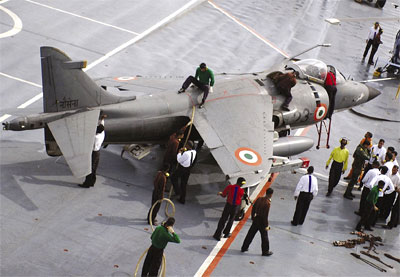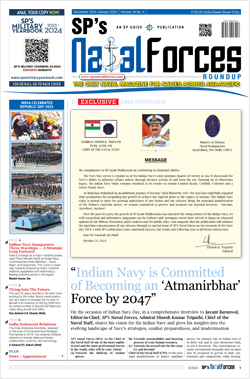INDIAN ARMED FORCES CHIEFS ON OUR RELENTLESS AND FOCUSED PUBLISHING EFFORTS

The insightful articles, inspiring narrations and analytical perspectives presented by the Editorial Team, establish an alluring connect with the reader. My compliments and best wishes to SP Guide Publications.

"Over the past 60 years, the growth of SP Guide Publications has mirrored the rising stature of Indian Navy. Its well-researched and informative magazines on Defence and Aerospace sector have served to shape an educated opinion of our military personnel, policy makers and the public alike. I wish SP's Publication team continued success, fair winds and following seas in all future endeavour!"

Since, its inception in 1964, SP Guide Publications has consistently demonstrated commitment to high-quality journalism in the aerospace and defence sectors, earning a well-deserved reputation as Asia's largest media house in this domain. I wish SP Guide Publications continued success in its pursuit of excellence.
- MoD initiates comprehensive review of Defence Acquisition Procedure 2020, pushes for defence reforms
- G7: The Swansong
- Kalinga Connect: South Asia to Polynesia
- Advanced MRSAM for India for a greater firepower
- Must Credit DRDO for Operation Sindoor, now what is next for defence R&D?
- Operation Sindoor | Day 2 DGMOs Briefing
- Operation Sindoor: Resolute yet Restrained
Indian Navy
Transition to Blue Water

Being a technology intensive service, the IN requires upgradation of modernisation plans on a constant basis. Recent times have witnessed considerable openness, liberalisation and access to global market for frontline technologies.
“To be secure on land, we must be supreme at sea.”
—Pandit Jawaharlal Nehru
India’s maritime history dates back to some 5,000 years. The first recorded evidence of shipbuilding capability was found in a tidal dock built during the Indus Valley Civilization, around 2300 BC at Lothal on the Gujarat coast. In that era, the trade between India and its neigh-bouring states was essentially through sea for many centuries.
The Maurya, Satavahana, Chola, Vijayanagara, Kalinga, Maratha and Moghul empires, were all known to possess powerful navies. The Cholas excelled in foreign trade and maritime activity, extending their influ-ence overseas to China and Southeast Asia. The Maratha and Kerala produced the most powerful naval forces in the subcontinent and were credited with defeating European navies at various times during 17th and 18th centuries. Admirals Kanhoji Angre and Kunjali Marakkar came to be known as out-standing chiefs during that era.
Birth of the Indian Navy
Whilst the East India Company in 1612 established what was then known as the Honourable East India Company’s Marine, it was in 1830 that the British government set up British Indian Navy (IN). It is believed that the Mutiny of 1946 by the sailors of the Royal IN forced the British to hasten the process of Independence. Even after Independence, the Royal IN continued to function as such and was commanded by the British officers. On January 26, 1950 when India became a Republic, the birth of the IN took place with her ships designated as Indian Naval Ships. Vice Admiral R.D. Katari was the Indian offi-cer to take over as Chief of the Naval Staff on 22 April, 1958.
Roles and responsibilities assigned to the IN were as follows:
• In conjunction with other armed forces of the Union, act to deter or defeat any threats or aggression against the territory, people or mar-itime interests of India, both in war and peace;
• Project influence in India’s maritime areas of interest, to further the nation’s political, economic and security objectives;
• In cooperation with the Indian Coast Guard, ensure good order and stability in India’s maritime zones of responsibility;
• Provide maritime assistance, including disaster relief, in India’s maritime neighbour-hood; and
• Play a key role as part of ‘a pluralistic security order’ for a better world.
Operational Engagements
Since its inception, the IN has undertaken numerous operational assignments, a brief account of some of the important ones is enlisted here.
Operation Vijay, 1961: Indian naval ships provided gunfire support for naval and army landing troops to liberate Goa and success-fully sunk Portuguese frigate and patrol boats.
Indo-Pak Confl icts: During the Indo-Pakistan War of 1965, the IN’s role was restricted to patrolling the areas of conflict. During the 1971 war, however, the IN came of age with its two most innovative and daring attacks on Karachi harbour. The first attack, code-named Operation Trident, was launched on December 4. The second attack, Operation Python, was launched soon thereafter. On the eastern seaboard, sinking of Pakistan Navy’s submarine PNS Ghazi heralded the Indian blockade of erstwhile East Pakistan through naval aircraft, Sea Hawks and Alizés, operating from the INS Vikrant. In addition frigate and ASW Ships were deployed in Bay of Bengal. Loss of the INS Khukri was a major setback. Complete control over exit and ingress ensured a total naval blockade of Karachi Port and the erstwhile East Pakistani ports.
Operation Cactus: In 1988, the INS Godavari with Indian marine commandos on board was quickly diverted to proceed with despatch to intervene in a hijack attempt of a vessel by a rebel group PLOTE of Maldives who had held a senior minister hostage on board. This action decisively put paid the attempt of coupe at Maldives.
Operation Talwar: Amid the heat of Kargil conflict during 1999, the frontline ships of both Western and Eastern Fleets were formed into a task force which was deployed in the Northern Arabian Sea to safeguard India’s maritime assets against any possible misadventure by the Pakistan Navy.
Operation Parakram: To meet any kind of fallout from the tense situations during 2001-02, the IN was fully deployed and partici-pated in all joint forces exercises.
Operation Enduring Freedom: To counter the increasing menace of hijacking at sea, particularly in the region of Malacca Strait, Indian naval ships undertook convoy protec-tion and security role on the high seas, in the latter part of 2001. This operation was called Operation Enduring Freedom and earned global accolades for the country.
Disaster Relief & Rescue Operations
Operation Madad: The IN deployed 27 ships, 19 helicopters, six naval aircraft and over 5,000 naval personnel in an unprec-edented disaster relief operations, post Tsunami 2004. These area specific relief operations were launched for different states. Operation Madad was for Andhra Pradesh and Tamil Nadu, Operation Sea Waves for Andaman and Nicobar Islands, Operation Castor in Maldives, Operation Rainbow in Sri Lanka and Operation Gambhir in Indonesia. To augment existing capabilities in this spe-cialised area, a Landing Platform Dock INS Jalashwa, formerly the USS Trenton, was acquired in 2007, besides the ongoing indig-enous shipbuilding projects, to continually upgrade the amphibious fleet.
Operation Sukoon: A large force under the command of Flag Officer Commanding, Western Fleet was deployed off Lebanon to evacuate 2,286 Indian nationals and expatri-ates, including 436 Sri Lankan and 69 Nepali citizens, from war-torn Lebanon.
Anti-piracy operations
In a first of its kind, a coordinated action by the ships of the IN and the Indian Coast Guard had successfully led to release of a hijacked Japanese cargo ship, the MV Alondra Rainbow, from pirates.
Piracy off the coast of Somalia: The IN, by deploying its stealth frigate INS Tabar in October 2008, emerged as one of the first to respond to crisis situation perpetuated by pirates operating around the coast of Somalia and the Gulf of Aden. Frontline destroyer INS Mysore was also deployed to augment the anti-piracy operations. On a request from the Seychelles government, patrol by naval ships in the area was intensified which resulted in the arrest of nine pirates. The INS Savitri, an Offshore Patrol Vessel, has recently been deployed in the region for constant vigil and to create a secure environment.





